+ Open data
Open data
- Basic information
Basic information
| Entry | Database: PDB / ID: 6p9x | ||||||||||||||||||
|---|---|---|---|---|---|---|---|---|---|---|---|---|---|---|---|---|---|---|---|
| Title | CRF1 Receptor Gs GPCR protein complex with CRF1 peptide | ||||||||||||||||||
 Components Components |
| ||||||||||||||||||
 Keywords Keywords | MEMBRANE PROTEIN / GPCR | ||||||||||||||||||
| Function / homology |  Function and homology information Function and homology informationcorticotropin-releasing hormone activity / positive regulation of digestive system process / positive regulation of corticosterone secretion / regulation of adenylate cyclase activity involved in G protein-coupled receptor signaling pathway / corticotropin-releasing hormone binding / positive regulation of circadian sleep/wake cycle, wakefulness / negative regulation of circadian sleep/wake cycle, REM sleep / regulation of corticosterone secretion / corticotrophin-releasing factor receptor activity / corticotropin-releasing hormone receptor activity ...corticotropin-releasing hormone activity / positive regulation of digestive system process / positive regulation of corticosterone secretion / regulation of adenylate cyclase activity involved in G protein-coupled receptor signaling pathway / corticotropin-releasing hormone binding / positive regulation of circadian sleep/wake cycle, wakefulness / negative regulation of circadian sleep/wake cycle, REM sleep / regulation of corticosterone secretion / corticotrophin-releasing factor receptor activity / corticotropin-releasing hormone receptor activity / corticotropin-releasing hormone receptor 2 binding / corticotropin secretion / positive regulation of corticotropin secretion / positive regulation of cortisol secretion / regulation of serotonin secretion / general adaptation syndrome, behavioral process / negative regulation of glucagon secretion / MECP2 regulates transcription of neuronal ligands / positive regulation of behavioral fear response / glucocorticoid biosynthetic process / negative regulation of norepinephrine secretion / parturition / hormone-mediated apoptotic signaling pathway / negative regulation of luteinizing hormone secretion / negative regulation of epinephrine secretion / monoatomic ion homeostasis / cellular response to corticotropin-releasing hormone stimulus / negative regulation of voltage-gated calcium channel activity / varicosity / behavioral response to ethanol / positive regulation of cAMP-mediated signaling / response to ether / fear response / neuropeptide hormone activity / synaptic transmission, dopaminergic / G protein-coupled peptide receptor activity / negative regulation of systemic arterial blood pressure / Class B/2 (Secretin family receptors) / regulation of NMDA receptor activity / cellular response to cocaine / diterpenoid metabolic process / exploration behavior / adrenal gland development / hypothalamus development / response to pain / response to aldosterone / response to corticosterone / positive regulation of calcium ion import / locomotory exploration behavior / positive regulation of insulin secretion involved in cellular response to glucose stimulus / associative learning / PKA activation in glucagon signalling / hair follicle placode formation / response to immobilization stress / mu-type opioid receptor binding / developmental growth / corticotropin-releasing hormone receptor 1 binding / intracellular transport / D1 dopamine receptor binding / Hedgehog 'off' state / beta-2 adrenergic receptor binding / adenylate cyclase-activating adrenergic receptor signaling pathway / activation of adenylate cyclase activity / adenylate cyclase activator activity / cellular response to dexamethasone stimulus / trans-Golgi network membrane / female pregnancy / long-term synaptic potentiation / ionotropic glutamate receptor binding / insulin-like growth factor receptor binding / lung development / G-protein beta/gamma-subunit complex binding / Olfactory Signaling Pathway / bone development / Activation of the phototransduction cascade / G beta:gamma signalling through PLC beta / Presynaptic function of Kainate receptors / Thromboxane signalling through TP receptor / G-protein activation / adenylate cyclase-activating G protein-coupled receptor signaling pathway / G protein-coupled acetylcholine receptor signaling pathway / Activation of G protein gated Potassium channels / Inhibition of voltage gated Ca2+ channels via Gbeta/gamma subunits / hormone activity / Prostacyclin signalling through prostacyclin receptor / Glucagon signaling in metabolic regulation / G beta:gamma signalling through CDC42 / cognition / ADP signalling through P2Y purinoceptor 12 / G beta:gamma signalling through BTK / Synthesis, secretion, and inactivation of Glucagon-like Peptide-1 (GLP-1) / Sensory perception of sweet, bitter, and umami (glutamate) taste / photoreceptor disc membrane / platelet aggregation / Adrenaline,noradrenaline inhibits insulin secretion / Glucagon-type ligand receptors / Vasopressin regulates renal water homeostasis via Aquaporins / G alpha (z) signalling events / cellular response to catecholamine stimulus / Glucagon-like Peptide-1 (GLP1) regulates insulin secretion Similarity search - Function | ||||||||||||||||||
| Biological species |  Homo sapiens (human) Homo sapiens (human) | ||||||||||||||||||
| Method | ELECTRON MICROSCOPY / single particle reconstruction / cryo EM / Resolution: 2.91 Å | ||||||||||||||||||
 Authors Authors | Belousoff, M.J. / Liang, Y.L. / Sexton, P. / Danev, R. | ||||||||||||||||||
| Funding support |  Australia, Australia,  Japan, 5items Japan, 5items
| ||||||||||||||||||
 Citation Citation |  Journal: Mol Cell / Year: 2020 Journal: Mol Cell / Year: 2020Title: Toward a Structural Understanding of Class B GPCR Peptide Binding and Activation. Authors: Yi-Lynn Liang / Matthew J Belousoff / Peishen Zhao / Cassandra Koole / Madeleine M Fletcher / Tin T Truong / Villy Julita / George Christopoulos / H Eric Xu / Yan Zhang / Maryam Khoshouei / ...Authors: Yi-Lynn Liang / Matthew J Belousoff / Peishen Zhao / Cassandra Koole / Madeleine M Fletcher / Tin T Truong / Villy Julita / George Christopoulos / H Eric Xu / Yan Zhang / Maryam Khoshouei / Arthur Christopoulos / Radostin Danev / Patrick M Sexton / Denise Wootten /      Abstract: Class B G protein-coupled receptors (GPCRs) are important therapeutic targets for major diseases. Here, we present structures of peptide and Gs-bound pituitary adenylate cyclase-activating peptide, ...Class B G protein-coupled receptors (GPCRs) are important therapeutic targets for major diseases. Here, we present structures of peptide and Gs-bound pituitary adenylate cyclase-activating peptide, PAC1 receptor, and corticotropin-releasing factor (CRF), (CRF1) receptor. Together with recently solved structures, these provide coverage of the major class B GPCR subfamilies. Diverse orientations of the extracellular domain to the receptor core in different receptors are at least partially dependent on evolutionary conservation in the structure and nature of peptide interactions. Differences in peptide interactions to the receptor core also influence the interlinked TM2-TM1-TM6/ECL3/TM7 domain, and this is likely important in their diverse signaling. However, common conformational reorganization of ECL2, linked to reorganization of ICL2, modulates G protein contacts. Comparison between receptors reveals ICL2 as a key domain forming dynamic G protein interactions in a receptor- and ligand-specific manner. This work advances our understanding of class B GPCR activation and Gs coupling. | ||||||||||||||||||
| History |
|
- Structure visualization
Structure visualization
| Movie |
 Movie viewer Movie viewer |
|---|---|
| Structure viewer | Molecule:  Molmil Molmil Jmol/JSmol Jmol/JSmol |
- Downloads & links
Downloads & links
- Download
Download
| PDBx/mmCIF format |  6p9x.cif.gz 6p9x.cif.gz | 197.6 KB | Display |  PDBx/mmCIF format PDBx/mmCIF format |
|---|---|---|---|---|
| PDB format |  pdb6p9x.ent.gz pdb6p9x.ent.gz | 156 KB | Display |  PDB format PDB format |
| PDBx/mmJSON format |  6p9x.json.gz 6p9x.json.gz | Tree view |  PDBx/mmJSON format PDBx/mmJSON format | |
| Others |  Other downloads Other downloads |
-Validation report
| Summary document |  6p9x_validation.pdf.gz 6p9x_validation.pdf.gz | 1007.2 KB | Display |  wwPDB validaton report wwPDB validaton report |
|---|---|---|---|---|
| Full document |  6p9x_full_validation.pdf.gz 6p9x_full_validation.pdf.gz | 1013.8 KB | Display | |
| Data in XML |  6p9x_validation.xml.gz 6p9x_validation.xml.gz | 36.9 KB | Display | |
| Data in CIF |  6p9x_validation.cif.gz 6p9x_validation.cif.gz | 57 KB | Display | |
| Arichive directory |  https://data.pdbj.org/pub/pdb/validation_reports/p9/6p9x https://data.pdbj.org/pub/pdb/validation_reports/p9/6p9x ftp://data.pdbj.org/pub/pdb/validation_reports/p9/6p9x ftp://data.pdbj.org/pub/pdb/validation_reports/p9/6p9x | HTTPS FTP |
-Related structure data
| Related structure data |  20277MC  0993C  6p9yC M: map data used to model this data C: citing same article ( |
|---|---|
| Similar structure data | |
| EM raw data |  EMPIAR-10361 (Title: Cryo-EM of CRF1 receptor bound to CRF and Gs protein / Data size: 2.6 TB EMPIAR-10361 (Title: Cryo-EM of CRF1 receptor bound to CRF and Gs protein / Data size: 2.6 TBData #1: Unaligned multi-frame gain-normalized movies in LZW compressed TIFF format [micrographs - multiframe]) |
 Movie
Movie Controller
Controller Assembly
Assembly



 UCSF Chimera
UCSF Chimera


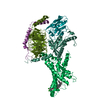
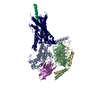

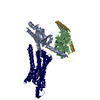
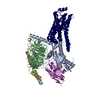
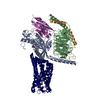



 PDBj
PDBj